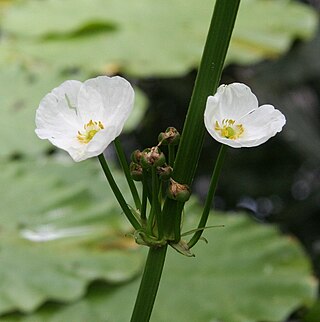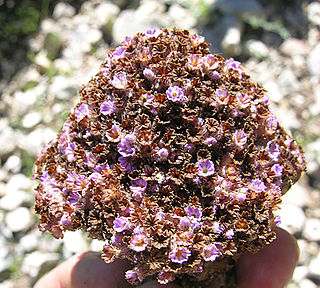
Yucca elata is a perennial plant, with common names that include soaptree, soaptree yucca, soapweed, and palmella. It is native to southwestern North America, in the Sonoran Desert and Chihuahuan Desert in the United States, southern Nevada, southwestern Utah, and northern Mexico. Yucca elata is widely distributed, although its population appears to be decreasing.

Hesperoyucca whipplei, the chaparral yucca, our Lord's candle, Spanish bayonet, Quixote yucca or foothill yucca, is a species of flowering plant closely related to, and formerly usually included in, the genus Yucca. It is native to southwest communities of North America.

Yucca filamentosa, Adam's needle and thread, is a species of flowering plant in the family Asparagaceae native to the southeastern United States. Growing to 3 metres tall, it is an evergreen shrub valued in horticulture.

Echinodorus subalatus is a species of aquatic plants in the Alismataceae. It is native to Cuba, Mexico, Central America, Guyana, Venezuela, Bolivia, Brazil and Paraguay. It is found naturally growing in mud by the side of streams.

Yucca gloriosa is a species of flowering plant in the family Asparagaceae, native to the southeastern United States. Growing to 2.5 m (8 ft), it is an evergreen shrub. It is widely cultivated as an ornamental for its architectural qualities, and has reportedly become established in warmer climates in the wild in various parts of the world.

Allium cernuum, known as nodding onion or lady's leek, is a perennial plant in the genus Allium. It grows in open areas in North America.

Yucca gigantea is a species of flowering plant in the asparagus family, native to Mexico and Central America. Growing up to 8–12 m (26–39 ft) in height, it is an evergreen shrub which is widely cultivated as an ornamental garden or house plant, often referred to simply as yucca cane. The edible flower is the national flower of El Salvador locally called izote, and it is used extensively in Salvadoran cuisine.

Tillandsia ionantha, the air plant, is a species of plant in the genus Tillandsia. This species is native to Central America and Mexico. It is also reportedly naturalized in Broward County, Florida.

Yucca × schottii is a plant species in the genus Yucca, native to southern Arizona, southwestern New Mexico, and the northern parts of Sonora and Chihuahua. The common names are Schott's yucca, hoary yucca, and mountain yucca. The "×" in the name indicates that this is a nothospecies, regarded as being a natural hybrid between two other species. In this case, Yucca × schottii is believed to have originated as a hybrid between Y. baccata and Y. madrensis. Yucca × schottii is firmly established and does reproduce freely in the wild.

Bouteloua hirsuta, commonly known as hairy grama, is a perennial short prairie grass that is native throughout much of North America, including the Great Plains and Canadian Prairies region, as well as Mexico and Guatemala.
Smilax moranensis is a plant species in the family Smilacaceae. It is native to mountainous areas in Mexico from Sonora and Chihuahua south to Chiapas.

Yucca lacandonica is a plant species in the yucca genus with the common name "tropical yucca." It is native to Belize and to southern Mexico, the states of Chiapas, Veracruz, Tabasco, Quintana Roo, Campeche, and Yucatán. It is uniquely the only epiphytic species in the genus, although it has been reported to grow terrestrially as well.

Yucca thompsoniana, the Thompson's yucca, is a plant in the family Asparagaceae, native to Texas, Chihuahua and Coahuila. Other names for the plant include Beaked yucca, Soyate and Palmita.
Trixis inula, the tropical threefold, is a plant species native to Texas, Mexico, Central America, northern South America, and the West Indies. It is found on open, sandy sites such as roadsides, thorn scrub, thickets, etc.

Celtis ehrenbergiana, called the desert hackberry or spiny hackberry, is a plant species that has long been called C. pallida by many authors, including in the "Flora of North America" database. It is native to Arizona, Florida, New Mexico and Texas, and to Latin America as far south as central Argentina. It grows in dry locations such as deserts, brushlands, canyons, mesas and grasslands.

Ardisia escallonioides, the Island marlberry, is a plant species native to the West Indies and neighboring areas. It has been reported from Barbados, Bermuda, the Dominican Republic, Cuba, Mexico, Belize, Guatemala and Florida.
Cyathea holdridgeana, synonym Cyathea albomarginata, is a species of tree fern native to Panamá and Costa Rica. It grows in wet forests at elevations of 2400–2800 m, considerably higher than most other tree ferns of Central America.
Iresine heterophylla, or Standley's bloodleaf, is a plant species native to the southwestern United States and also to Mexico. It has been collected from Arizona, New Mexico, Texas, Chihuahua, Sonora, Durango, Coahuila, Nuevo León, Campeche and Tabasco.

Bouvardia ternifolia, the firecracker bush, is a shrub widespread across much of Mexico, the range extending south into Honduras and north into the southwestern United States.

Lennoa is a monotypic genus of flowering plants belonging to the family Boraginaceae. It only contains one known species, Lennoa madreporoidesLex. It is within the subfamily of Lennoaceae.



















